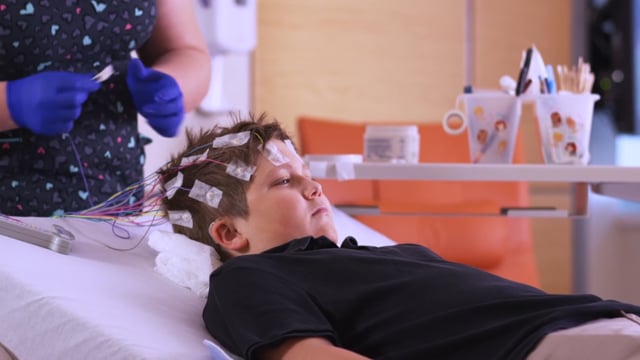- Parents Home
- Para Padres
- A to Z Dictionary
- Allergy Center
- Asthma
- Cancer
- Diabetes
- Diseases & Conditions
- Doctors & Hospitals
- Emotions & Behavior
- First Aid & Safety
- Flu (Influenza)
- Food Allergies
- General Health
- Growth & Development
- Heart Health & Conditions
- Homework Help Center
- Infections
- Newborn Care
- Nutrition & Fitness
- Play & Learn
- Pregnancy Center
- Preventing Premature Birth
- Q&A
- School & Family Life
- Sports Medicine
- Teens Home
- Para Adolescentes
- Asthma
- Be Your Best Self
- Body & Skin Care
- Cancer
- Diabetes
- Diseases & Conditions
- Drugs & Alcohol
- Flu (Influenza)
- Homework Help
- Infections
- Managing Your Weight
- Medical Care 101
- Mental Health
- Nutrition & Fitness
- Q&A
- Safety & First Aid
- School, Jobs, & Friends
- Sexual Health
- Sports Medicine
- Stress & Coping
EEG (Electroencephalogram)
What Is an Electroencephalogram (EEG)?
An electroencephalogram (EEG) is a test used to find problems related to electrical activity of the brain.
An EEG tracks and records brain wave patterns. Small metal discs with thin wires (electrodes) are placed on the scalp, and then send signals to a computer to record the results. Normal electrical activity in the brain makes a recognizable pattern. Through an electroencephalogram (ih-lek-tro-en-SEF-uh-lo-gram), doctors can look for abnormal patterns that indicate seizures and other problems.
Why Is an EEG Done?
Most EEGs are done to diagnose and monitor seizure disorders. EEGs also can identify causes of other problems, such as sleep disorders and changes in behavior. They're sometimes used to check brain activity after a severe head injury or before a patient gets a heart transplant or liver transplant.

Getting an EEG
An electroencephalogram measures the electrical activity in a person’s brain. An EEG is usually done in the hospital or a doctor’s office, and doesn’t hurt.
How Can I Help My Child Prepare for an EEG?
If your child is getting an EEG, their hair should be clean and free of oils, sprays, and conditioner to help the electrodes stick to the scalp.
You can help prepare your child for the test by explaining that it won't be uncomfortable. You can describe the room and the equipment that will be used, and reassure your child that you'll be right there for support. For older kids, be sure to explain the importance of keeping still during the EEG so it won't have to be repeated.
Doctors may recommend that a child stop taking certain medicines before the test. They often recommend that kids not have caffeine up to 8 hours before an EEG. If your child will need to sleep during the EEG, the doctor will suggest ways to help make this easier.
What Happens During an EEG?
An EEG can be done in the doctor's office, a lab, or a hospital. Your child will be asked to lie on a bed or sit in a chair. The EEG technician will attach electrodes to different locations on the scalp using adhesive paste. Each electrode is connected to an amplifier and EEG recording machine.
The electrical signals from the brain are converted into wavy lines on a computer screen. Your child will be asked to lie still because movement can change the results.
If the goal of the EEG is to mimic or cause the problem your child is having (like seizures), they might be asked to look at a bright flickering light or breathe a certain way. The health care provider doing the test will know your child's medical history and will be ready for any issues that could come up during it.
How Long Does an EEG Take?
Most EEGs take about an hour. If your child needs to sleep during it, the test will take longer. You might be able to stay in the room with your child, or you can step outside to a waiting area.
When Are the Results Ready?
A neurologist (a doctor who treats nervous system disorders) will read and interpret the results. Though EEGs vary in complexity and duration, results usually are available in a few days.
Are There Any Risks From an EEG?
EEGs are very safe. If your child has a seizure disorder, your doctor might want to stimulate and record a seizure during the EEG. A seizure can be triggered by flashing lights or a change in breathing pattern.
What if I Have Questions?
If you have questions about the EEG, talk to your doctor. You can also talk to the EEG technician before the exam.
What Else Should I Know?
An EEG isn't uncomfortable and patients don't feel any shocks on the scalp or elsewhere. Still, having electrodes pasted to the scalp can be a little stressful for kids, as can lying still during the test. Reassure your child that the test is needed but won't take long, and that you'll be nearby.

© 1995- The Nemours Foundation. KidsHealth® is a registered trademark of The Nemours Foundation. All rights reserved.
Images sourced by The Nemours Foundation and Getty Images.
